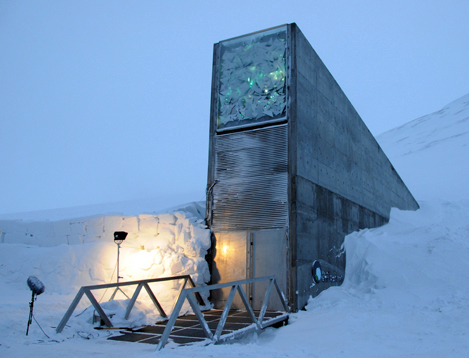| << Chapter < Page | Chapter >> Page > |
Since the 1920s, government agriculture departments have maintained seed banks of crop varieties as a way to maintain crop diversity. This system has flaws because over time seed varieties are lost through accidents and there is no way to replace them. In 2008, the Svalbard Global seed Vault, located on Spitsbergen island, Norway, ( [link] ) began storing seeds from around the world as a backup system to the regional seed banks. If a regional seed bank stores varieties in Svalbard, losses can be replaced from Svalbard should something happen to the regional seeds. The Svalbard seed vault is deep into the rock of the arctic island. Conditions within the vault are maintained at ideal temperature and humidity for seed survival, but the deep underground location of the vault in the arctic means that failure of the vault’s systems will not compromise the climatic conditions inside the vault.

The Svalbard seed vault is located on Spitsbergen island in Norway, which has an arctic climate. Why might an arctic climate be good for seed storage?
Although crops are largely under our control, our ability to grow them is dependent on the biodiversity of the ecosystems in which they are grown. That biodiversity creates the conditions under which crops are able to grow through what are known as ecosystem services—valuable conditions or processes that are carried out by an ecosystem. Crops are not grown, for the most part, in built environments. They are grown in soil. Although some agricultural soils are rendered sterile using controversial pesticide treatments, most contain a huge diversity of organisms that maintain nutrient cycles—breaking down organic matter into nutrient compounds that crops need for growth. These organisms also maintain soil texture that affects water and oxygen dynamics in the soil that are necessary for plant growth. Replacing the work of these organisms in forming arable soil is not practically possible. These kinds of processes are called ecosystem services. They occur within ecosystems, such as soil ecosystems, as a result of the diverse metabolic activities of the organisms living there, but they provide benefits to human food production, drinking water availability, and breathable air.
Other key ecosystem services related to food production are plant pollination and crop pest control. It is estimated that honeybee pollination within the United States brings in $1.6 billion per year; other pollinators contribute up to $6.7 billion. Over 150 crops in the United States require pollination to produce. Many honeybee populations are managed by beekeepers who rent out their hives’ services to farmers. Honeybee populations in North America have been suffering large losses caused by a syndrome known as colony collapse disorder, a new phenomenon with an unclear cause. Other pollinators include a diverse array of other bee species and various insects and birds. Loss of these species would make growing crops requiring pollination impossible, increasing dependence on other crops.

Notification Switch
Would you like to follow the 'Bmcc 102 - concepts of biology' conversation and receive update notifications?